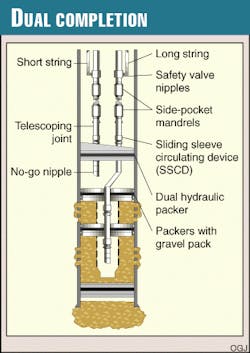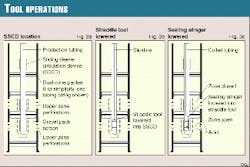Brunei Shell Petroleum Co. Sdn Bhd. increased oil producing rates from its acid stimulation program, offshore Brunei, by incorporating permanently installed downhole sliding-sleeve circulation devices (SSCDs), straddle tools, and coiled-tubing stingers for gravel-packed zones.
Fig. 1 illustrates a typical dual-zone well in which both tubing strings are fitted with SSCDs as permanent completion components. The SSCDs are designed to last for the production life of the well.
SSCDs are necessary for receiving straddle tools and coiled-tubing stingers that are used for isolating perforations and controlling or directing acid pumped through coiled tubing.
These tools, combined with slickline and coiled tubing, allowed Brunei Shell to treat individual perforated zones while continuously circulating and without having to kill the well. Without these isolation devices, the operator would have had to bullhead in the fluid by pressurizing the entire tubing string.
Bullheading cannot ensure that all zones are properly stimulated or that all tubing is protected from acid.
Brunei Shell's stimulation objectives included:
- Removing wellbore damage caused by fines and sand migration or completion and workover fluids.
- Cleaning out sand fill and sodium chloride deposits in the tubing.
SSCD
The industry has used SSCDs (Fig. 2a) for many years to allow fluid circulation between the tubing and tubing-casing annulus. Typical applications involve using the devices for cleaning up completion fluids before production starts and for selectively producing multiple zones.
Most SSCDs provide a locking profile and seal bore above the internal sleeve and an additional seal bore below. This arrangement allows flow-control devices, run on either slickline or coiled tubing, to be located adjacent to the flow ports.
The internal shifting sleeve is designed with redundant stacks of nonelastomer "vee" packing seals, designed for dynamic applications and long-term service. For treating of the lower zone, the upper zone is closed and the lower zone is opened by a slickline shifting device.
SSCDs are designed with equal flow area through the inside diameter and through the port area of the internal sleeve. This feature provides full-flow capabilities and reduces the effects of flow-induced wear.
Straddle tool
The straddle or isolation tool assembly (Fig. 2b) is designed to be installed in an SSCD. The sleeve on the circulating device must be in the open position before the straddle tool is run into the well.
The straddle assembly can be run in on a conventional wireline setting tool, or installed with an hydraulic service tool on coiled tubing.
The equalizing valve on the straddle assembly is run in the open position during installation. This prevents fluid lock while the assembly traverses polished bores in the various downhole nipples.
A prong attached to the running tool closes the equalizing valve after the straddle assembly is set downhole in the appropriate profile.
The SSCD, isolated by the upper and lower seals of the straddle tool, allows the other SSCDs in the tubing string to be left open, if desired.
Stinger tool
The stinger tool attached to coiled tubing (Fig. 2c) enables pumped fluids to enter the formation through the straddle tool and SSCD.
Stinger tool components engage straddle-tool lugs, reducing the hang-off weight seen by the coiled tubing operator and indicating to the operator that the stinger has contacted the straddle assembly.
As the operator picks up the coiled tubing, the straddle-tool lugs latch into mating slots in the stinger, causing an immediate increase in pickup weight. This increase in weight indicates that the stinger is engaged, and pumping can begin.
Fig. 2d shows the stinger tool inserted into the straddle tool.
Operations
In Fig. 3a, the SSCD assembly is permanently located adjacent to the perforated zone to be treated. The assembly was installed as part of the production tubing string when the well was initially completed.
For the acidizing treatments, Brunei Shell used a slickline to lower the straddle tool into the SSCD (Fig. 3b).
After the straddle tool was in place, the next step installed the sealing stinger, run on coiled tubing, into the straddle tool assembly.
Treating the lower zone involved closing off the upper zone and opening access to the lower zone with a slickline shifting device.
When the stinger tool is latched into the straddle assembly (Fig. 8), its seal is within the polished bore of the straddle assembly ported sub. This arrangement allows stimulation fluid to pass through the assembly into only the zone being treated.
After completion of the stimulation program, one can release the stinger from the straddle assembly by slacking off on the coiled tubing. The stinger and coiled tubing can then be picked up to release the stinger for removal from the wellbore.
Typical stages in an acid job (based on 30 ft of net perforated sand, except for the solvent preflush that is a fixed amount) are as follows:
- 1. 1,000 gal of xylene solvent preflush.
- 2. 3,000 gal of 10% hydrochloric (HCl) double-strength iron (Fe) acid preflush.
- 3. 3,000 gal of 9 to 1 HCl and hydrofluoric (HF) mud acid.
- 4. 1,500 gal of 5% HCl double-strength acid overflush.
- 5. 1,500 gal of 5% sodium chloride (NH4Cl) brine overflush.
- 6. 7,500 gal of 8% potassium chloride (KCl) brine for displacement.
For intervals longer than 30 ft, one can pump the treating stages in several cycles, with foam diverters separating each cycle.
Brunei Shell required about 5 days to complete an acid job in the long string, as follows:
- Install equipment on platform-0.75 day.
- Run wireline to prepare long string for sand cleanout-0.75 day.
- Clean out sand from long string-0.75 day.
- Run wireline to prepare string for acidizing-0.5 day.
- Test formation injectivity and stimulate zone-1 day.
- Run wireline to prepare long string for production-0.5 day.
- Recover equipment and initiate production from well-0.75 day.
Results
The acid treatments successfully treated several wells, with wellbore deviations between 50 and 57°.
In one well, without production prior to the treatment, two zones started producing after the stimulation treatment. Six months after the treatment, one zone was producing 100 cu m/day (620 b/d) with a 60% water-oil cut. The other zone, 24 months after the treatment, was still producing 60 cu m/day with a 10% water-oil cut.
A zone in a second well, 6 months after the treatment, was producing 20 cu m/day with a 50% water-oil cut. The zone had no production prior to the work.
Production from a zone in a third well was 510 cu m/day with a 2% water-oil cut 1 month after the treatment. This compares to a 105 cu m/ day producing rate prior to the treatment.
The Authors
Oddbjorn Skilbrei is a production technologist for Brunei Shell Petroleum Sdn Bhd. in the Brunei Champion field area. He previously worked for Phillips Petroleum Co. as a field reservoir-production engineer and for Nederlandse Aardolie Maatschappij B.V. (NAM) as a production technologist for offshore gas fields.
Skilbrei holds an MS in petroleum engineering from Norwegian Technical University, Trondheim.
Richard K. Smith is senior account leader for Halliburton Worldwide Ltd. in Brunei. He is responsible for all financial and business development for Brunei Shell Petroleum and Elf Petroleum Asia BV. Smith holds a BS and an MS in petroleum engineering from West Virginia University.
James Tucker is the team leader for coiled-tubing tools at Halliburton's technology center in Duncan, Okla. Tucker holds BS and MS degrees in mechanical engineering from Oklahoma State University, Stillwater. He is a registered professional engineer in Oklahoma.
Kenneth McIntyre is a coiled-tubing advisor and technologist for Halliburton's technology center in Duncan, Okla. He has more than 18 years' experience in well servicing, specializing in surface equipment, downhole equipment, and applications.
Robert C. Hammett is principal engineer for Halliburton's subsurface-flow controls design group in Carrollton, Tex. He is responsible for the design of production tubing completion equipment and slickline tools. Hammett holds a BS in mechanical engineering from the University of Virginia. He is a registered professional engineer in Texas.









